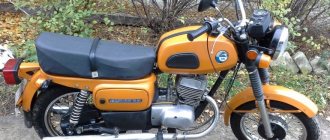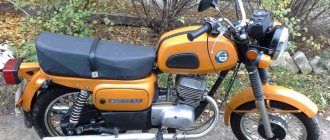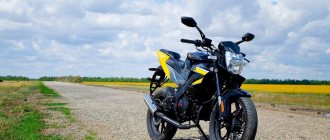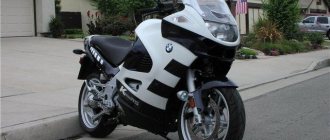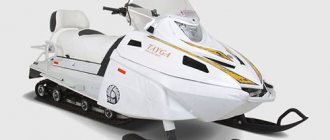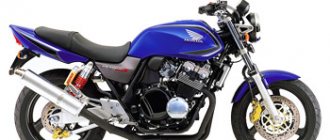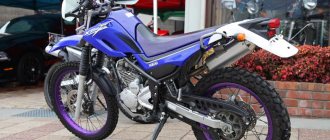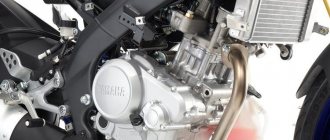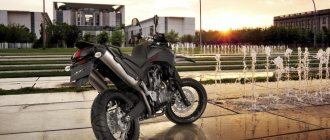RU-MOTO rating
- Reliability
- Chassis
- Appearance
- Comfort
4.3
Verdict
— The motorcycle has good technical characteristics and is quite playful. — Maximum speed 120 km per hour. Unfortunately, it will be unsafe to travel any longer. — Good build quality, allowing you to drive up to 10 thousand km without visiting a service station. - Cost-effective. Fuel consumption is 1.5 liters per 100 km with moderate driving. By filling the 12-liter tank, you can drive until exhausted. - Acceptable price. Indeed, compared to its competitors, Yamaha has the most optimal price/quality ratio.
Yamaha motorcycles have long been famous for their quality, performance and style. The motorcycle products produced are suitable for both beginners and extreme riding enthusiasts. The Yamaha YBR125 combines such qualities as reliability, unpretentiousness, maintainability and relatively low cost. Having a light weight and size allows you to move comfortably around the city and rough terrain. According to reviews from professionals, it is the best choice for a beginner.
Read other motorcycle reviews Full review of the Kawasaki Ninja 300 motorcycle
Yamaha YBR125 - profile view
YBR125 is quite common in Russia and Ukraine. In 2010, the 4th generation of this series was released. The motorcycle is now equipped with an injector. Received some appearance changes with the addition of side plastic and a round headlight. Unfortunately, at the moment, the fourth generation is not supplied to Russia and Ukraine.
It copes with its functions wonderfully. It’s easy to quickly get from point A to point B through traffic jams. The high-spirited 125 cc engine allows you to accelerate to speeds of up to 120 km per hour. More is possible, but the engine will wear out.
As for gluttony, even the most economical engines will envy it. The Yamaha R125 consumes only 3 liters per 100 km during moderate driving and up to 4.5 liters when driving at high speeds. There is no need to prove that the motorcycle copes well with the function of quickly moving around the city and beyond, this is already obvious.
001_MOTO_0910_034
Yamaha YBR125: classic, 2004–2010, 123.7 cm³, 10 hp, 117 kg, 40,000–80,000 rub.
Yamaha YBR125: classic, 2004–2010, 123.7 cm³, 10 hp, 117 kg, 40,000–80,000 rub.
It turned out that in order to prepare a dish that can satisfy the gastronomic needs of absolutely diverse and versatile people, ultra-modern technologies and exotic delights of famous restaurant chefs are not at all required. For most, the fundamental principle is still “cheap and cheerful.” How else can we explain that the simple and unpretentious “octagonal” Yamaha YBR125 sold in Europe alone with a circulation exceeding 75 thousand copies? And it’s impossible to count how many of them were sold in Asia and Latin America. Yes, yes, exactly Latin America. After all, the recipe for motorcycle “fast food” appeared in 2000 thanks to the Brazilian branch of the Yamaha Motor do Brasil corporation and was originally intended for the local Spanish- and Portuguese-speaking market: a two-valve single-shaft “single-barrel”, a simple steel frame, minimally sufficient brake mechanisms, simple suspension... Then what do you need! The demand for the Yamaha YBR125 was so great that assembly of the model was also organized in Mexico and Colombia. And in 2003, they were joined by a joint venture with the Chinese company Jianshe Industries Co., Ltd in Southeast Asia. It was from there that the lion's share of these motorcycles subsequently came to Europe. It came to Russia even earlier than European countries - in 2004. In general, various modifications of the Yamaha YBR125 for different markets differ significantly from each other: place of production, plastic hitch, brakes, headlights, wheels, power systems. We were imported exclusively carburetor motorcycles from China with a rectangular headlight and a plastic half-fairing. These are what we will mainly be talking about.
A little history of the model
Since the introduction of Yamaha YBR 125 motorcycles, they have undergone many improvements and changes, becoming better and more reliable.
Yamaha YBR 125 first generation
2004 – launch of sales of the first generation Yamaha YBR 125. In Russia, only versions with a trapezoid-shaped headlight and semi-fairing were sold. Features of this generation are:
- The wheels are three-spoke, tube tires.
- The gearbox pedal is short in length, which is inconvenient to use for people with large feet.
2007 - the second generation motorcycles were launched on sale, which did not change much in appearance, but they changed technically:
- The carburetor was improved, so that idle speed was easier to regulate.
- The gearbox pedal has been lengthened.
- Swapped out the dark gray color for light gray and the stickers on the plastic.
Yamaha YBR 125 third generation
2008 - the modified third generation Yamaha EBR 125 went on sale, this time the motorcycle is already noticeably different from its predecessors. It had the following features:
- The wheels are five-spoke, tubeless tires.
- Heated carburetor.
- Chainring with mounting holes located in different locations, but the same size as before.
- On the rear fender, the location and method of attaching the turn signals has changed (attached using plastic clips). The turn signals themselves have become more streamlined and compact.
- The low beam began to turn on automatically when the ignition was turned on.
- A sensor for the side stand not being retracted appears on the panel.
- The brake pads, calipers, discs, front forks, mirrors and colors were also updated.
2010 - the company developed the fourth generation YBR 125 motorcycle. It has a significantly updated appearance, but these motorcycles are not supplied to Russia.
011_MOTO_0910_034
POWER UNIT. A real success for Yamaha designers. The engine has been tested by time and barbaric operating conditions on the roads of the “third world”, and therefore has long been cured of most “childhood diseases”. The owners make up legends about its reliability and unpretentiousness, citing as weighty arguments the hundred and fifty thousand mileage and autonomous circumnavigation of some copies without major repairs. Needless to say, the engine consumes and easily digests almost any fuel and oil. If only the oil itself was changed at least once every 4,000 kilometers. At the same time, the oil-guzzling characteristic of some Yamaha models sometimes appears when the odometer exceeds 35 thousand kilometers, and disappears again with the replacement of piston rings and valve bushings. So it's no surprise that the YBR125 isn't the only bike in Yamaha Motors' slender line-up to use this engine. This list is impressive: XT125R/X, TT-R125, DT125RE, XTZ125E/XE... Some third-party manufacturers (for example, Sherco CityCorp 125) did not disdain the motor.
By the way, wide unification with Yamaha off-road models has one extremely positive side effect: for this engine there are several options for increasing the displacement from the standard 123.7 cm³ to a soul-warming 130–170 cm³. Similar tuning kits (for example, ProCycle, BBR Motorsports or Powroll) include a new cylinder-piston group, a camshaft with extended valve timing and sometimes even a crankshaft with an increased piston stroke. And in order to fully unleash the potential of the engine, you can at the same time install a new Keihin or Mikuni VM26 carburetor with a Ø26 mm diffuser and an engine control unit made by BBR Motorsports, which raises the upper limiter response zone by 1000 rpm. However, you will have to tinker with the release yourself, since the commercially available versions of complete systems for the TT-R125 or XT125R/X on the YBR125 will only fit at the point of attachment to the cylinder head. But the final result should be worth all the pain, because the engine will add about 5-7 “horses” to the existing ten. Some archaic design of the power unit is manifested in the requirement to inspect the thermal clearance of the valves every 6000 km. Neglecting service intervals leads to increased rattling noise from the cylinder head. But you shouldn’t be too afraid: the openness of access to the valves and the simplicity of the adjustment mechanism (screw - nut) make the already simple procedure elementary. But another characteristic noise from the cylinder head should alert you. Due to overheating, it may be necessary to replace crackling camshaft bearings. You can’t delay repairs - the “wedge” of the bearing and the subsequent meeting of the valves with the piston will cost many times more.
In general, bearings marked Made in China are the real bane of the Yamaha YBR125. They do not differ in manufacturing precision, and therefore often fail. For example, some motorcycles have lost bearings in the gearbox after covering a couple of tens of thousands of kilometers. The defect manifested itself in the form of a howl in fifth gear at 5000–6000 rpm. The gearbox itself is reliable without reservations - you just need to change gears correctly, so as not to have to worry about the second one “jumping out”, and to restore the clarity of gear shifting on well-traveled examples, it is enough to replace the pedal return spring.
In addition, when choosing, you should carefully examine the copies produced in 2007–2008, when the Mikuni BS25 “vacuum unit” replaced the proven Mikuni VM22. Unfortunately, the more advanced design did not add any advantages; rather, on the contrary: not only did the power decrease, but this carburetor is also famous for excessively leaning the mixture. When driving for a long time at a cruising speed of around 100 km/h, this leads, at a minimum, to burnt valves and deterioration in dynamics. Therefore, the return in 2009 to the “old friend” Mikuni VM22 (albeit now with fuel heating) was quite natural.
The clutch can withstand a lot even with hard use in motorcycle schools and makes you notice it only after 30–40 thousand kilometers.
Similar models
Currently, there are quite a lot of small motorcycles in the 125 cc class on the market. The motors of other models are approximately similar in parameters, only the build quality differs. Many owner reviews and reviews show that the Yamaha EBR 125 is the most practical in its category.
However, if you want to save money, you can consider purchasing similar motorcycles, for example: Cobra Crossfire 125, Baltmotors S1 or Guowei GW125. Keep in mind that even a newly supported ebrik will be more reliable than any of these new motorcycles.
006_MOTO_0910_034
Stylish is only available for “Europeans” with a round headlight.
Stylish is only available for “Europeans” with a round headlight.
UPGRADES TABLE
| Years of manufacture | Major design changes |
| 2004–2006 | “simple” carburetor with cylindrical throttle Mikuni VM22SHshort gearshift pedal |
| 2007–2008 | Mikuni BS25 vacuum type carburetor; the ergonomics of the model have changed slightly to make it more convenient for tall drivers; the length of the gear shift pedal has been increased |
| 2009–2010 | new 5-spoke wheels for tubeless tires new front brake caliper low beam always on a return to the “simple” Mikuni VM22X1 carburetor, but now with fuel heating side stand sensor |
CHAIN. With unenviable regularity, sometimes after 5000–8000 kilometers, you have to change the original chain, which, taking into account the not very outstanding power of the device, is a very modest result. To prevent the price tag for the original spare part from making holes in the family budget, many are trying to find a replacement for it in the form of “Java” Favorit chains. But, as practice has shown, they “live” even less, and there is simply no point in installing them, despite the rather humane price list. The surest option is to install an O-Ring type chain, as on the 2009-2010 modification, or an X-Ring from a renowned manufacturer, which will reliably serve for at least 15,000 kilometers.
CHASSIS. There is no need to expect revelations here. It copes with its direct purpose—to move from point “A” to point “B”—tolerably well. Fortunately, no one demands anything else from her. When purchasing, you should pay attention to the alignment of the wheels - there have been cases where the frame came out of the factory gate deformed. The rear shock absorbers, although they last a long time, are designed, rather, for a skinny Chinese worker, which is why they often break. The situation is saved by replacing them with more energy-intensive “non-original” ones. The seals in the front fork suffer, often giving out at around 3,000 kilometers. To somehow increase their life, it is enough to install rubber corrugations on the fork legs (suitable from “Pilot”). The pendulum bushings (they begin to creak at 8,000 kilometers) and the rear wheel axle (after 20 thousand kilometers simply bend in an arc) cannot withstand domestic roads and increased loads. However, while there are still smart turners on the territory of the ex-USSR, it will not be difficult to agree on the production of a new axle that is stronger, from 30KhGSA steel. Against this background, the reliability of the steering column bearings will pleasantly surprise you - they “nurse” for at least 40 thousand kilometers. The bearings in the rear wheel have approximately the same service life, and in the front - twice as long.
BRAKES. A single front brake disc with a single-piston floating caliper at the front and a rear “drum” are just enough for the dynamic capabilities of the car. At the same time, installing a reinforced hose only adds sensitivity to the front brake, without affecting the overall efficiency.
ELECTRICAL. Usually does not create problems. The most common complaints are about the luminous flux produced by the original headlight: the near one illuminates a small spot in front of the motorcycle, and the distant one snatches road signs from the darkness, but not the road itself. The adjustment range is not enough to lower the headlight to the desired angle. Replacing a standard 35W/35 lamp with a similar, more powerful one only partly solves the problem of lack of light: due to a weak generator, in this case the battery is intensively discharged, especially when driving within the city.
ACCESSORIES. Among the factory additional equipment, only arches that protect the engine are available to Russian buyers. When dropped, they cope with their task tolerably - the engine remains intact, but the fairing with the headlight built into it and the instrument panel suffer. Craftsmen find a compromise in installing arcs from IZH. From him, most often, they borrow a headlight after unsuccessful falls. As for all kinds of cases, there are several interesting specimens in the aftermarket. But you shouldn’t overload: the carrying capacity of the trunk, to which, in fact, it is attached, does not exceed three kilograms. A disregard for factory requirements actually backfires: at one point, the central trunk leaves the motorcycle along with the trunk torn out “with meat.”
EVERYONE HAS OWN YBR. There are dozens of modifications of the YBR125 that exist but are practically unknown to Russian consumers. For example, for Europe and China, the Celestial Empire produces a chopper-shaped version with the Custom prefix. But if it comes to the Old World in a single version, then for the Chinese there are at least four of them, including a special “police” version. The true “Chinese” differs from the one we know only in the presence of a front license plate mount, as well as other air intakes under the tank. Is it possible to make simple things simpler? Can! For the domestic market, the Brazilian branch of Yamaha produces an even more budget version - on spokes and with drum brakes on both wheels.
Advantages of a motorcycle
Controllability
Ease of control of a motorcycle is a very important characteristic for novice bikers; the Yamaha EBR 125 has an excellent one, since it has low weight and power, as well as reliable brakes. It is convenient for maneuvering in city conditions, where there is not enough space on roads and in yards, and it also accelerates confidently. Many motorcycle schools use it as a training model; it is ideal for learning to drive and smoothes out all the mistakes that a beginner can make.
Reliability
The Yamaha YBR 125 is very simply designed, and you have to try really hard to break it. If the battery suddenly runs out, it starts easily with a pushrod or kick starter. In the event of a breakdown, even a novice motorbike enthusiast will be able to understand what exactly is broken thanks to the elementary design.
Economical
Considering the fuel consumption is 3 liters per 100 km and the gas tank volume is 13 liters, many owners of the Yamaha YBR 125 refuel once or twice a week. It turns out that a full tank is enough for 350-400 km.
It is economical in terms of oil consumption: the EBR 125 only needs to be filled with 1 liter of oil, whereas most motorcycles need to be filled with 2.5 - 3 liters.
As for the transport tax, it is much lower for small 125cc motorcycles than for larger ones.
Fuel consumption is 3 liters per 100 km, the volume of the gas tank is 13 liters. A full tank is enough for 350-400 km.
Patency
The Yamaha YBR 125 performs well on country roads and even off-road. Naturally, this is not an enduro and it will be problematic to overcome a mud pit, but it can handle the rest with ease. If necessary, you can install suitable tires on it and its cross-country ability will increase even more. However, keep in mind that you should not jump on an ebrike; the suspension is not designed for this kind of driving and may break.
Well, in case of big difficulties on the way, the YBR 125 can simply be carried by hand, since it weighs a little more than 100 kilograms.
Easy to repair
Spare parts for the Yamaha EBR 125 are very easy to obtain and are inexpensive. Therefore, in case of damage, you can always repair it without problems. And if you install protective bars on a motorcycle, then it will be almost impossible to cause any harm to it.
A common failure among beginners is damage to the plastic headlight fairing when falling to the side. In this case, it is recommended to simply replace the headlight with a round one. All parts for 125 cc bikes are quite cheap, and if you don’t fall or have an accident, you will be able to ride the Yamaha YBR 125 for a long time without repairs.
Liquidity
Since the start of production of Yamaha YBR motorcycles, they have been actively purchased in Russia, and therefore it will not be difficult to find this model for a small amount and in good condition. And when you outgrow this motorcycle, you can easily sell it.
015_MOTO_0910_034
ESTIMATED COST OF SPARE PARTS Yamaha YBR125
| Name | Original spare parts, rub. | Non-original spare parts, rub. |
| Air filter | 1000 | 1000 (Hiflo) |
| Spark plug | 800 (NGK-Yamaha) | 160 (NGK CR6HSA) |
| Chain | 7200 | 3000 (RK 428 GXW) |
| Clutch discs | 3500 | 4200 (reinforced Barnett) |
| Clutch springs (set) | 600 | 1500 (reinforced by BBR Motorsports) |
| Front brake pads | 1500 | 1100 (EBC FA.101 (2004–2008) or EBC FA.464 (2009–2010)) |
| BBR Motorsports tuning kit to increase displacement to 150 cm³ with camshaft | — | 16000 |
| Takegawa wide timing camshaft | — | 9000 |
| Carburetor Mikuni VM26 | — | 10500 |
| BBR Motorsports Engine Control Unit | — | 6000 |
| Safety bars | 5500 (chrome), 3800 (black) | 5140 (Crazy Iron) |
| Rear shock absorbers (set) | 9000 | from 7000 (YSS) |
| Spare parts, mostly available in stock. |
| Spare parts are sometimes in stock. |
| Spare parts, mainly imported to order. |
We thank Alexey “Samodelkin” and the Internet portal YBRclub.com for their help in preparing the material.
Bestseller: Yamaha YBR125
Tuning and modifications of Yamaha YBR125
Tuning Yamaha YBR125 is like a drug. The availability of inexpensive spare parts and accessories makes modifications affordable, financially, and very fun. To begin with, I threw out the standard trunk, which had the inscription “no more than 3 kg” on it. My backpack with a tent, sleeping bag and fuel weighs 15 kilograms, and I was not at all happy about losing it on the road. I ordered a new, reinforced tourist trunk with a chrome frame from Ali.
In the nostalgia for the chopper, Steed's fringed leather side cases also found their place. Tuned mirrors of increased size and chrome handles look like original ones. Next season, I plan to change the rear Izhevsk shock absorbers to Honda ones from the SV400. Relatives were taken in the fall, when my friend and I were preparing for our first long-distance trip on the Ebr. The owners' fantasies are amazing. Some people install additional cooling, others use a pendulum on rolling bearings, I’ve also seen YBR-enduro on super “evil” tires.
Main technical characteristics of two-wheeled vehicles
The engine has one cylinder with two valves and four strokes. The power unit of the motorcycle, tilted forward and air cooled, is equipped with a SOHC system. Engine capacity – 124 cm2. Power 7 thousand rpm: 10 l/hp.
A wet sump is installed as a lubrication system. The equipment is equipped with an electronic fuel injection carburetor. Multi-plate clutch with wet spring.
A transistorized TCI ignition system is used. 5-speed transmission, chain drive, electric start.
The frame of the equipment is made in the form of a rhombus. The fork of technology is the telescope. Tire sizes: front – 2.75-18 42P. Rear – 90/90-18 M/C 57P.
Motorcycle dimensions: length/width/height – 1985/745/1080. Data are given in millimeters. The height of the bike at the saddle is 780 mm.
Ground clearance 160 mm. Filling the fuel tank is 13 liters. The oil system capacity holds 1.2 liters. Total weight with technical fluid is 185 kilograms.
The motorcycle is endowed with high technical indicators:
- Speed capabilities are 120 km/h.
- High build quality allows you to avoid maintenance visits and travel 10 thousand km without problems.
- Fuel consumption is 1.5 liters per hundred with moderate driving. Average consumption is 3 liters.
We note the moderate cost and high build quality in comparison with competitors.
Of course, like other small-capacity motorcycles, the Yamaha has a significant drawback - low speed. This motorcycle is designed for moderate and relatively quiet riding, but it quickly gets boring. Unfortunately, you cannot squeeze more than 120-130 km/h out of it, and this figure also varies greatly depending on your weight.
Fourth generation. It's getting steeper and steeper...
Due to strange circumstances, the new model, the 4th generation Yamaha YBR125, is not for sale in Russia. You can only buy a Euro, produced from 2010 to 2021, with mileage, from Japan or Europe. This problem does not stop 125 fans. The price for a 2021 motorcycle without mileage in the Russian Federation is approximately 150,000.00 rubles. Not that much money for a dream.
I was lucky to drive a 2013 125 a couple of times, which my neighbor brought from Japan this spring. Having admired the Yamaha YBR 125 photo enough, studied the innovations on the forums far and wide, I got on the motorcycle with a little excitement.
Of course, it differs from previous models, primarily in its more cheerful design and more ergonomic and durable plastic. On the subject of Yamaha YBR125 technical specifications, number 4, which ignite everyone's curiosity:
- an injector has appeared, making starting easier at any temperature,
- added gear engaged indicator,
- a choke button was placed on the steering wheel,
- added a glove compartment under the seat
- the leading star has undergone changes,
- the brakes and the appearance of the rear turn signals have been improved,
- the front brake became two-piston.
How to adjust valves?
There is nothing complicated in such a procedure if you have the necessary tools at hand and adhere to a certain algorithm. First of all, you need to prepare:
- 8 mm socket head;
- knob;
- 17 mm head;
- probes for 0.08 and 0.1 mm;
- wrench 24 and 8 mm.
When the instruments are prepared, valve adjustment begins in accordance with the following algorithm:
- To gain access to the necessary elements, dismantle the plastic insert held in place by latches.
- The timing cover is removed. To do this, unscrew the mounting bolts using an 8 mm socket.
- Remove the valve covers with a 24 mm wrench.
- A 17 mm socket rotates the camshaft clockwise. This action is repeated until the marks are aligned.
- Begin the valve adjustment procedure using two feeler gauges intended for the exhaust valve. One of them is inserted between the adjusting bolt and the valve. When the probe moves freely, the adjustment procedure begins.
- The lock nut of the adjusting bolt is loosened, after which it must be rotated using a special wrench until the probe travel becomes tight.
- The locknut is tightened and the bolt is kept from turning accidentally.
When the procedure is completed, it is necessary to return all dismantled elements to their place in the reverse order.
It’s interesting with us on the highway and during rush hour
This is a bright representative of road conquerors with a small cubic capacity and a serious inner world: a four-stroke power unit and a five-speed gearbox.
The bike is equipped with a lightweight, reliable chassis, efficient suspension and good brakes: front disc, rear drum.
A comfortable double seat provides comfort during long hauls and waiting in traffic jams. The motorcycle is easy to maintain. The mid-range power unit runs like a well-oiled clock. The operation of the gearbox is not satisfactory. We can say that this technique is intended for those who saddled a two-wheeled horse for the first time.
The technology seems to have been created for residents of the metropolis, for whom it is important to arrive at the appointed place at the exact appointed time. The motorcycle cuts through traffic jams like a knife through butter and bypasses hours-long traffic jams. Although experienced motorcyclists also like to ride a bike.
It’s a pleasure to ride with a minimal tuning kit, including fork corrugations, hand protection, a round headlight and good quality tires. The tuned suspension will create competition for its two-wheeled brothers.
Photo: Ideal fit for people 175 cm tall.
